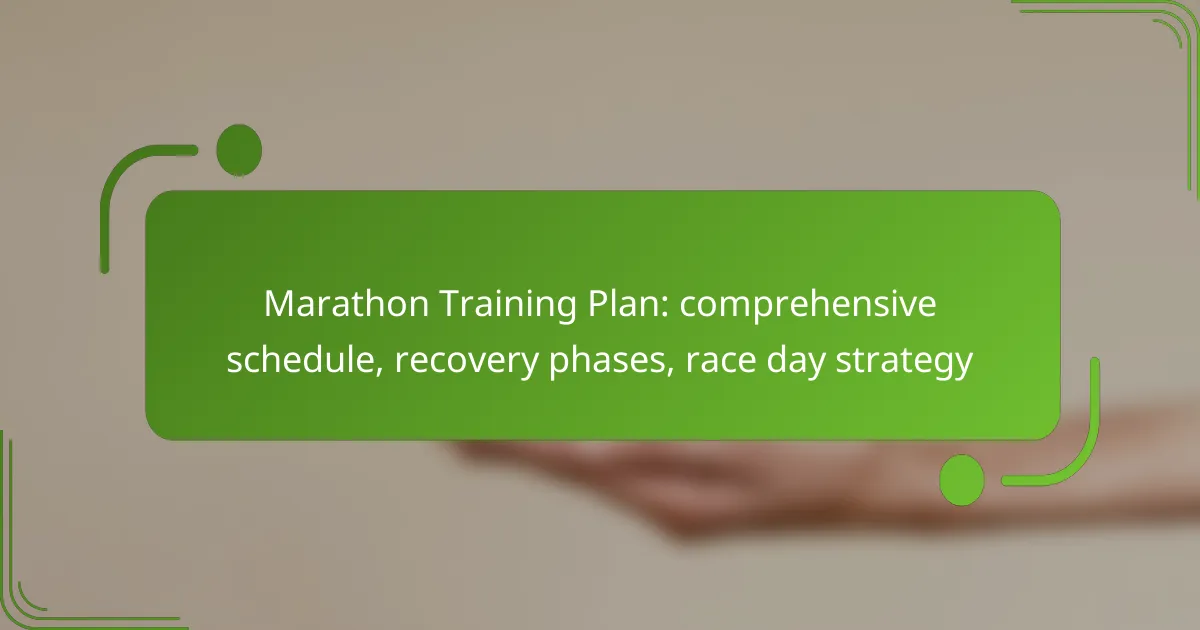A comprehensive marathon training plan is essential for runners aiming to successfully complete a marathon. This structured schedule incorporates long runs, speed work, and recovery phases to build endurance and optimize performance. Additionally, effective recovery strategies and race day tactics play a crucial role in ensuring a successful and enjoyable marathon experience.

What is a comprehensive marathon training plan?
A comprehensive marathon training plan is a structured schedule designed to prepare runners for a marathon, typically spanning several weeks. It includes various training elements such as long runs, speed work, and recovery phases to enhance endurance and performance on race day.
12-week training schedule
A 12-week training schedule is a common framework for marathon preparation, allowing gradual mileage increases and adaptation. Most plans start with a base of consistent running, gradually incorporating longer runs and speed workouts.
For example, the first few weeks may focus on building a weekly mileage of around 20-30 miles, while the final weeks peak at 40-50 miles. Adjustments can be made based on individual fitness levels and experience.
Key training phases
The key training phases include base building, peak training, and tapering. Base building focuses on establishing a solid running foundation, while peak training emphasizes high mileage and intensity to improve speed and endurance.
Tapering, the final phase, involves reducing mileage to allow the body to recover and prepare for race day. This phase typically lasts 2-3 weeks and is crucial for optimal performance.
Weekly mileage breakdown
A typical weekly mileage breakdown might include a mix of easy runs, a long run, and speed work. For instance, a week could consist of 4-5 days of running, with easy runs totaling 20-30 miles, a long run of 10-20 miles, and a speed workout of 5-8 miles.
It’s important to listen to your body and adjust mileage based on how you feel, ensuring you avoid injury while still building endurance.
Long run importance
Long runs are essential in a marathon training plan as they build endurance and simulate race conditions. Typically scheduled once a week, these runs should gradually increase in distance, reaching up to 20 miles in the weeks leading up to the marathon.
These sessions help your body adapt to prolonged exertion and improve mental toughness, both crucial for completing a marathon successfully.
Cross-training recommendations
Cross-training is beneficial for enhancing overall fitness while reducing the risk of injury. Activities such as cycling, swimming, or strength training can complement running by improving muscle balance and cardiovascular fitness.
Aim for 1-2 cross-training sessions per week, focusing on low-impact activities that allow recovery while maintaining fitness. This approach can help prevent burnout and keep training enjoyable.

How do I recover effectively during marathon training?
Effective recovery during marathon training is crucial for enhancing performance and preventing injuries. It involves a combination of rest, active recovery, proper nutrition, and hydration strategies to help your body heal and adapt after intense workouts.
Importance of rest days
Rest days are essential for muscle repair and overall recovery. They allow your body to rebuild stronger and reduce the risk of overtraining, which can lead to injuries. Incorporating at least one full rest day per week is recommended for most marathon training plans.
During rest days, it’s beneficial to focus on mental recovery as well, giving yourself a break from the physical and psychological demands of training. This can enhance motivation and performance in subsequent workouts.
Active recovery techniques
Active recovery techniques involve low-intensity activities that promote blood flow without straining your muscles. Options include walking, light cycling, or swimming. These activities can help reduce muscle soreness and stiffness following intense runs.
Consider incorporating yoga or stretching sessions into your routine to improve flexibility and aid recovery. Aim for 20-30 minutes of active recovery activities on your rest days to maintain movement without overexertion.
Nutritional strategies for recovery
Nutrition plays a vital role in recovery. Consuming a balanced meal or snack rich in carbohydrates and protein within 30 minutes post-run can help replenish glycogen stores and repair muscle tissue. Aim for a ratio of about 3:1 carbohydrates to protein for optimal recovery.
Incorporate whole foods like fruits, vegetables, lean meats, and whole grains into your diet. Supplements like protein shakes can be useful but should not replace whole food sources. Monitor your overall caloric intake to ensure you meet your energy needs during training.
Hydration tips
Staying hydrated is crucial for recovery and performance. Aim to drink water consistently throughout the day, especially after long runs. A general guideline is to consume at least half your body weight in ounces of water daily, adjusting based on activity level and climate.
Consider electrolyte-rich drinks after intense workouts, particularly in hot weather, to replenish lost minerals. Monitor your urine color as a simple indicator of hydration; pale yellow typically indicates adequate hydration, while darker shades suggest a need for more fluids.

What strategies should I use on race day?
On race day, effective strategies can significantly enhance your performance and enjoyment. Key areas to focus on include pacing, nutrition, warm-up routines, and mental preparation.
Pacing strategies
Establishing a pacing strategy is crucial for maintaining energy throughout the marathon. Aim for a consistent pace that aligns with your training runs, typically within a range of 10-20 seconds per mile slower than your goal race pace.
Consider using a negative split approach, where you run the second half of the race faster than the first. This strategy can help you conserve energy early on and finish strong, especially in the latter miles when fatigue sets in.
Nutrition and hydration plan
Your nutrition and hydration plan should be tailored to your needs and the race conditions. Aim to consume 30-60 grams of carbohydrates per hour during the race, which can come from gels, chews, or sports drinks.
Hydration is equally important; drink water or an electrolyte beverage at regular intervals, typically every 15-20 minutes. Adjust your intake based on weather conditions, aiming for about 500-700 mL of fluids per hour.
Warm-up routines
A proper warm-up routine prepares your body for the demands of the marathon. Start with light jogging for 10-15 minutes to increase your heart rate, followed by dynamic stretches targeting major muscle groups.
Incorporate drills like high knees and butt kicks to activate your muscles and improve flexibility. Aim to complete your warm-up about 30 minutes before the race starts to allow your body to settle before the gun goes off.
Mental preparation techniques
Mental preparation is key to race day success. Visualization techniques can help; spend time imagining yourself running the race, overcoming challenges, and crossing the finish line strong.
Additionally, practice positive affirmations to build confidence. Remind yourself of your training and the effort you’ve put in, which can help alleviate pre-race anxiety and boost your focus during the marathon.

What are the prerequisites for marathon training?
Before starting a marathon training plan, it’s essential to meet certain prerequisites that ensure you are physically and mentally prepared. These include having a solid base fitness level, prior race experience, and considering any health factors that may affect your training.
Base fitness level requirements
A good base fitness level is crucial for successful marathon training. Ideally, you should be able to comfortably run for at least 30 minutes without stopping before beginning a marathon plan. This ensures that your body is accustomed to the demands of running.
Most training programs recommend starting with a weekly mileage of around 15 to 20 miles. Gradually increasing your distance over several weeks will help build endurance and strength, which are vital for completing a marathon.
Previous race experience
Having previous race experience can significantly enhance your marathon training. Participating in shorter races, such as 5Ks or half-marathons, helps you understand race day logistics, pacing, and mental strategies. This experience can make the transition to marathon training smoother.
If you are new to racing, consider completing a half-marathon before attempting a full marathon. This will give you a taste of long-distance running and help you gauge your readiness for the marathon distance.
Health considerations
Health considerations play a vital role in determining your readiness for marathon training. It’s important to assess your overall health and consult with a healthcare professional if you have any pre-existing conditions or concerns. Conditions such as asthma, heart issues, or joint problems may require special attention.
Additionally, ensure you are following a balanced diet and staying hydrated. Proper nutrition supports your training and recovery, while hydration helps prevent injuries and fatigue. Listen to your body and adjust your training as needed to avoid overtraining or injury.

How do I choose the right gear for marathon training?
Selecting the right gear for marathon training is crucial for performance and injury prevention. Focus on comfort, fit, and functionality when choosing your equipment, particularly shoes, clothing, and accessories.
Running shoe selection
Choosing the right running shoes is essential for marathon training. Look for shoes that provide adequate cushioning, support, and stability based on your foot type and running style. It’s advisable to visit a specialty running store for a fitting, where staff can analyze your gait and recommend suitable options.
Consider the terrain you’ll be training on. If you plan to run primarily on trails, opt for trail running shoes that offer better grip and durability. For road running, lightweight shoes with good cushioning are typically preferred. Aim to replace your shoes every 300 to 500 miles to maintain optimal performance.
When trying on shoes, wear the socks you plan to use on race day. Ensure there’s enough space in the toe box to prevent discomfort during long runs. A good rule of thumb is to have about a thumb’s width of space between your longest toe and the end of the shoe.
